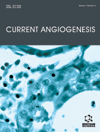Current Angiogenesis (Discontinued) - Current Issue
Volume 4, Issue 1, 2015
-
-
Prognostic Value of CD34 Positive Cells in the Lumen of Tumor Vessels in Breast Cancer
More LessBackground/Objective: The role of circulating endothelial cells in tumor progression was noted by many researchers. The purpose of this research was to study the relationship of free (unrelated to the wall of vessel) CD34 positive cells (F-CD34+) located in the lumen of tumor vessels with features of angiogenesis, clinical and morphological characteristics of breast cancer (BC). Materials and Methods: The tumor samples re Read More
-
-
-
The State-of-Art in Angiogenic Properties of Latex from Different Plant Species
More LessBackground: The development of drugs capable of enhance or inhibit the cell proliferation is an area in expansion at modern biomedical sciences. Recent researches have shown that latex has strong angiogenic potential. Methods: We performed a bibliometric analysis on the global literature trying to identify: the main scientometrics data, the botanical families and species, the angiogenic or antiangiogenic properties and also Read More
-
-
-
Vascular Endothelial Growth Factor: A New Paradigm for Targeting Various Diseases
More LessAuthors: Snehal S. Patel, Niti Rajshree and Abhinav ChavadaVascular endothelial growth factor is a signaling protein, which is responsible for the angiogenesis process. Variation in its expression leads to various disorders like cancer, diabetes, psoriasis and neuronal imbalance (depression) etc. The abundance of VEGF (VEGF-A, B, C) concentration is present in the kidney, heart, lung, ovary, thyroid gland, neurons, embryonic tissue etc. The regulation of VEGF expression is controlled b Read More
-
-
-
Targeting Tumor Angiogenesis in Gastrointestinal Malignancies
More LessAuthors: Paul R. Kunk, Erika Ramsdale and Osama E. RahmaGastrointestinal [GI] malignancies are common and frequently lethal neoplasms. As our understanding of GI cancers deepens, more pathways are discovered that play key roles in tumorigenesis and metastasis. Angiogenesis has emerged as a critical pathway in many cancers, particularly in GI cancers. The discovery of a complex network of signals, including vascular epithelial growth factor [VEGF], led to the emergence of a ne Read More
-
-
-
Extracellular Matrix on the Phenotypic Switching of Vascular Smooth Muscle Cells
More LessAuthors: Zhongjiang Chen, Yi Fu and Wei KongBackground: Vascular smooth muscle cells (VSMCs) show eminently plasticity during physiological and pathological processes. VSMCs undergo from contractile phenotype to proliferative, matrigenic, inflammatory or osteogenic phenotype during the pathogenesis of hypertension, atherosclerosis, and vascular calcification etc. Methods: Here we reviewed the research papers regarding to the respective effects of extracellular matri Read More
-
Volumes & issues
Most Read This Month Most Read RSS feed
Article
content/journals/cag
Journal
10
5
false
en


